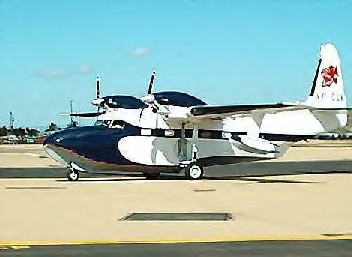Notwithstanding the fact that only three Goose amphibians had been sold to airlines before the war, a group of Grumman executives and engineers confidently felt that a twin-engined 10- to 15- seat amphibian would find a ready market after the war among feeder airlines. Moreover, they believed that a sound design to fit that market could be developed and produced at minimum cost by redesigning the G-21 and incoporating new production techniques. Accordingly, development of a fourth type of aircraft for the postwar civil market, the Design 73 twin-engined amphibian, was begun in December 1944 by a team led by Project Engineer Gordon Israel. Unfortunately for Grumman, airlines did not show the expected interest in the G-73 and total sales were disappointing. Although Design 73 did much better than G-63, G-65, and G-72 (which had not gone past the prototype stage), that success was only relative; only fifty-nine G-73s were built, whereas market studies on which Roy Grumman had based his go-ahead authorization had forecast a potential market for at least 250 twin-engined amphibians of that size and power.
As design progressed, the G-73 evolved into a larger, cleaner version of the G-21 with a tricycle undercarriage in place of the conventional undercarriage of the Goose. Normal accommodation was provided for a cockpit crew of two (later certificated for single-pilot operation) and for ten passengers in a cabin located beneath the wings, with access through a door on the port fuselage side, aft of the wings. A mooring hatch and a baggage compartment were located in the rear fuselage. Luxury accommodation with a couch, tables and 'overstuffed chairs' were offered as an option. Alternatively, five additional seats could be installed in place of the lavatory and rear baggage compartment.
As the G-73 was to be larger and heavier than the G-21, Grumman thought to replace the 450-hp engines of the earlier amphibian with engines in the 700 to 800-hp class. However, as no such suitable engines were available, Gordon Israel selected the Pratt & Whitney Wasp nine-cylinder radial to power its new amphibian. Most received Wasp S3H1s with take-off rating of 600 hp up to an altitude of 3,000 ft and normal rating of 550 hp at 5,000 ft, but some had Wasp S1H1s with take-off and normal ratings respectively maintained up to 6,200 ft and 8,000 ft. In both cases, the engines drove three-blade fully-feathering propellers. While reliable, these powerplant installations left the Mallard slightly underpowered. However, this was the only real shortcoming of the design as, on the water ground or in the air, the G-73 handled extremely well.
 Following the issue of an Approved Type Certificate on September 8, 1946, the first production aircraft was delivered to the McIntyre Porcupine Mines in Toronto, Canada on September 27. From then until March 1951 Grumman delivered fifty-six additional Mallards, mainly to private and industrial customers in the United States, Canada, Egypt, and Great Britain. Resales saw Mallards registered in Australia, Fiji, French Polynesia, Gabon, Indonesia, Japan, New Guinea, New Zealand, and Panama. The fifty-ninth and last Mallard was at first retained by Grumman but was later sold to Robertson & O'Connell Ltd, in Canada.
Following the issue of an Approved Type Certificate on September 8, 1946, the first production aircraft was delivered to the McIntyre Porcupine Mines in Toronto, Canada on September 27. From then until March 1951 Grumman delivered fifty-six additional Mallards, mainly to private and industrial customers in the United States, Canada, Egypt, and Great Britain. Resales saw Mallards registered in Australia, Fiji, French Polynesia, Gabon, Indonesia, Japan, New Guinea, New Zealand, and Panama. The fifty-ninth and last Mallard was at first retained by Grumman but was later sold to Robertson & O'Connell Ltd, in Canada.
The only military operator was the Egyptian Air Force which received two Mallards in 1949. However, these were not genuine military aircraft; they had been selected in preference to the smaller Short Sealand to equip the Royal Flight. Luxuriously appointed, they were used by HRM King Farouk until his overthrow in 1952. Later they were used by General Mohammed Haguib, Colonel Gamal Abdel Nasser, and visiting dignitaries.
Much to the dismay of those who had predicted that Mallards would sell well to air carriers, only one was sold by Grumman to an airline customer. Even then, the Mallard only had a short first career as an airliner, as Air Commuting went out of business within a year and its Grumman amphibian sold to Texaco. More luch attended the second coming of Mallard airliners as some of the aircraft acquired on the second-hand market beginning in the mid-1950s remained in service into the 1980s. They were operated in limited numbers by small regionial carriers in the United States, Canada, the Caribbean, Australia, Japan, and French Polynesia.
To solve the chronic lack of power which had limited the usefulness of the Mallard, one was fitted by Northern Consolidated Airlines with a 578-ehp Pratt & Whitney PT6A-6 propeller-turbine in place of its starboard Wasp radial engine. After some 50 hours of flying in 1964-65, this test bed was brought back to standard configuration. However, in 1968 it was once again modified, and this time both Wasps were replaced by 652-ehp PT6A-27 propeller-turbines. The resulting TurboMallard conversion was technically successful but only met with limited commercial success. Nevertheless, by the mid-1980s five TurboMallards were still operated from Watson Island in Miami.
After experiencing disappointing Mallard sales for four years, mainly due to the availability of low-priced surplus transport aircraft, Grumman was finnaly forced to terminate production of its twin-engined executive in 1951 due to restrictions on the use of aluminum and other strategic materials imposed as a result of the war in Korea.

Manufacturer: Grumman
Powerplant: Two Pratt & Whitney Wasp S1H1 radials
Wingspan: 66 ft 8 in
Length: 48 ft 4 in
Height: 18 ft 9 in
Wing area: 444 sq ft
